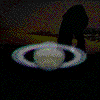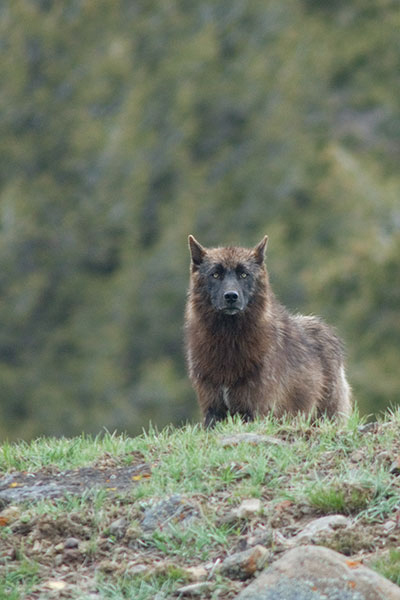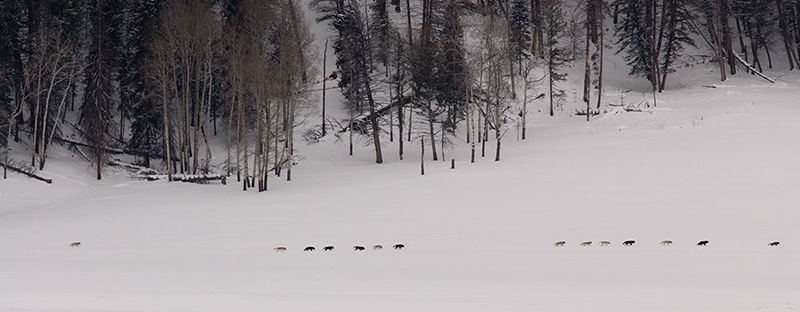 |
|
|
 |

“OF WOLVES”
"We have doomed the wolf not for what it is, but for what we deliberately and mistakenly perceive it to be -- the mythological epitome of a savage, ruthless killer -- which is, in reality, no more than the reflected image of ourself." Farley Mowat from Never Cry Wolf "We humans fear the beast within the wolf because we do not understand the beast within ourselves." Gerald Hausman "Throughout the centuries we have projected onto the wolf the qualities we most despise and fear in ourselves." Barry Lopez from Of Wolves and Men "The wolf is neither man's competitor nor his enemy. He is a fellow creature with whom the earth must be shared." L. David Mech
It is said the gray wolf represents the authentic incarnation of North American wilderness. It is said to witness the howl of wolves is to peer into the soul of that wildness. It is said the very gaze and vocalizations of wild wolves will reach deep into your essence and change you profoundly.
1 -- Late September 1990 -- Bowman Lake road -- northwest corner of Glacier National Park, 30 miles south of the Canadian border “Wow, this road has changed,” I thought as I drove wildly up the dirt from the tiny community of Polebridge and toward Bowman Lake. A cloud of offensive dust developed behind the car. It was late afternoon, autumn brisk clear and cool, but calm. No wind. That was important because I was here to obtain a new black-and-white photograph of Bowman Lake, some 30 miles up this remote thoroughfare. And the resultant photograph was hopefully to be used to develop a new rendering of a favorite place of mine; in this instance the photo would be hand-painted and defined under our recently developed photographic art-form Photofantasia, a joint effort with Cheryl. But the lake needed to be smooth and dead-calm, I figured, for the photograph to be successful. And it was getting late. The forest opened up as a result of an apparent recent forest fire, new since I had last visited. This development was disturbing, as my imagined shot required an unblemished boreal forest look surrounding the placid lake; while looking toward the snowcapped divide. The new openness allowed me to proceed more quickly (and more recklessly) up the road, however. I rounded the last turn, and entered the difficult-to-access Bowman Lake campground. The pier for canoes-only was directly ahead. I now thought also that any activity whatsoever on the lake would break up the smooth surface of the water, once again spoiling the shot. But I was in luck; no traffic, perfect calm and just enough light left. And there were only two other folks around, strolling quietly along the shoreline. As I furiously tore through the car to eventually locate the camera and tripod, I suspected those two viewed me as insane. But no matter. I quickly set up on the pier, carefully composed the potential image and began the very slowed and refined process of methodically clicking some photos, always checking focus and composition before and after each shot. Afterwards, I figured I had been successful at getting there at exactly the right moment, and nature had certainly cooperated. The results were “in the can.” “Now what?” I was miles from nowhere and it was getting dark. No problem. Bowman Lake was a wonderful place to camp, and there was only one other group. And no real issue if they consider me crazy -- certainly the better to spread out over the 40 or so nicely spaced car campsites, all with views and replete with firepits. I might even start a small campfire. “There is an ecstasy that marks the summit of life, and beyond which life cannot rise. And such is the paradox of living, this ecstasy comes when one is most alive, and it comes as a complete forgetfulness that one is alive. This ecstasy, this forgetfulness of living, comes to the artist, caught up and out of himself in a sheet of flame; it comes to the soldier, war-mad on a stricken field and refusing quarter; and it came to Buck, leading the pack, sounding the old wolf-cry . . .” Jack London from The Call of the Wild Off in the distance, “Ah-ooooooh.” And again. “What?” I moved away from the now disturbingly loud and annoying crackling fire. I was standing completely in the dark and near the quiet shores of Bowman Lake. Again, “Ah-ooooooh,” but this time with the inclusion of additional and obviously unique new voices. Coyotes? This wasn’t their typical yapping and barking. These soulful bayings were nothing like I had ever witnessed before. Could this possibly be the vocalization of wolves? I had never before witnessed them, and frankly never even considered their possible existence in this Glacier Park area, at least not until now. “Ah-ooooooh. Ah-ooooooh.” And then the music stopped. I waited patiently for more, eventually settling down on the gravel beach under the majesty of the Montana big dark sky, but there was no more. Just silence. The concert was over. "We listened for a voice crying in the wilderness. And we heard the jubilation of wolves!” Durwood L. Allen
2 -- Summer 1998 -- Kenai Peninsula, Alaska "I've always said that the best wolf habitat resides in the human heart. You have to leave a little space for them to live." Ed Bangs “Yeah, thanks,” I mumble as the transaction comes to conclusion. “One more thing.” “Yes?” “We’ve heard that wolves are seen around here. Is that true?” “Well, as a matter of fact, yes, it is true. You know that road just behind the store here; the one that circles partway around the lake?” “Yes?” “People who live along the lake occasionally see wolves behind their homes. The road goes right through there. It’s a dirt road, but easily driven.” The next morning Cheryl and I are up and running early, anxious to see just what might be visible along the road. We break our camp near the Russian River and drive to and begin up the road. It’s a dirt affair, supposedly not to be attempted with our rental sedan. We had signed several very official looking documents promising not to subject their precious car to such indignations; no matter, we’re en route. To our left at no more than 100 yards is the lake, with several modest dwellings constructed in the timber and along its banks. Ahead and to our right is an open field, with low foothills beyond. It really doesn’t look all that wild, but Alaska can surprise. Moose and bear are commonly seen walking the streets of small frontier towns. “Wait, there, do you see it?” “What?” “I think it’s a wolf, black, yes, it is a wolf, right there,” Cheryl exclaims with much excitement. “Where?” (I’m not so good at spotting wildlife. Cheryl’s always been much better.) “Right there!” “Oh no, now he’s down the bank and off. I don’t see him anymore.” I didn’t see him at all.
3 -- May, 2005 –- remote stretch of the Trading Post road within the Navajo Nation -- southeastern Utah near Montezuma Creek “(she) is a shapeshifter -- woman and wolf, hunter and hunted -- possessed of preternatural agility and strength, primal memories extending back thousands of years.” Alice Borchardt “What’s that?” Cheryl asked?” I pushed hard on the Trooper’s brakes, and as the post-river-trip-fully-loaded trailer clanked up on the rear bumper, we came to a sudden stop. “I’ve got no clue.” Before us, highly contrasted against the late morning desert landscape was a completely black canid (dog-like creature), gazing directly at us. Its long, somewhat gangly legs lifted its muscular body off the detail-less landscape and additionally highlighted "her" dusty, mangy jet-black coat. “Certainly not a fox. It looks a little like a coyote, wouldn’t you say?” “Yeah, except for the tail.” And it’s far too tall for a coyote. It is pretty scrawny, though.” “That figures; there’s not much to eat out here.” Soon after it appeared, the canid crossed and moved quickly and decisively away from the road and into the monochrome, nondescript desert landscape, disappearing from view. “Weird. How far is the trading post?” I asked, as we slowly got the big lumbering rig back up to speed. “There are no black coyotes.” Dr. James C. Halfpenny, wildlife biologist and expert wolf researcher
4 -- June 2005 -- Northern Range -- Yellowstone National Park “For the strength of the Pack is the Wolf, and the strength of the Wolf is the Pack." Rudyard Kipling from The Jungle Book Driving north up the Slough Creek drainage to camp, my friend Mark and I clear the hill and observe a very queer sight. Many dozens of vehicles and certainly hundreds of people litter the landscape before us. And out on every section of roadway, adjacent hillside and close-in meadow people are milling around, socializing, and most remarkably, gazing through a variety of sophisticated optical equipment. I pull over, as there is really no choice. As we make our way up one of the short hills and to a better vantage point (for what?) we are greeted by a friendly sort: “I’m sure they’ll be some observers with ’scopes up there, and perhaps they’ll point out some wolves to us. I think those guys above us may actually see wolves right now.” “We reached the old wolf in time to watch a fierce green fire dying in her eyes. I realized then, and have known ever since, that there was something new to me in those eyes -- something known only to her and to the mountain. I was young then, and full of trigger-itch; I thought that because fewer wolves meant more deer, that no wolves would mean hunters’ paradise. But after seeing the green fire die, I sensed that neither the wolf nor the mountain agreed with such a view.” Aldo Leopold from Sand County Almanac This famous quotation and related literature was perhaps the beginning of the American lament involving the human-caused annihilation of the wolf from Yellowstone during the early twentieth century. In many ways, this line of thought and associated (correct) assumptions about wolf’s impact on larger ecosystems catalyzed the idea of reintroduction. Rick McIntyre, Wolf Project member and helpful expert who is a daily year-round presence along the northern road, notes that he’s seen more wolves in Yellowstone in just a few years than he ever saw in Denali National Park over more than ten years. (The Wapiti, or American elk, the wolf’s main prey, were, from the very beginning, acutely aware of the wolf’s new-found Yellowstone appearance!) The next morning, I break camp and am in the running car at 5 am; a groggy and complaining Mark appears but is not all that happy. We drive perhaps two miles down to the hill we had noted last evening, park, and begin the ascent. Soon we are joined, and quickly overtaken, by two young women. We exchange greetings and offer to carry their gear, which includes sophisticated spotting ’scopes and a radio antenna with associated electronic mumbo-jumbo. They graciously reject our offer and, with Mark and I soon following badly, the four of us reach a small plateau and stop. She pulls out the antenna and hooks it up to a radio-type device. She turns on the switch and rotates the antenna until she appears to get a signal. Then she calmly aims up the ’scope (this takes perhaps fifteen to twenty seconds) and mutters something matter-of-factly. “Wolves travel in extended family groups, and these two older adult males have the responsibility of chaperoning the two pups until the pack reaches a new den. Neither is the pups’ genetic father,” she further articulates to us. After Erin’s female companion takes a look, she turns to Mark and asks: We’re almost a mile away. "Perhaps it was the eyes of the wolf, measured, calm, knowing. Perhaps it was the intense sense of family. After all, wolves mate for life, are loyal partners, create hunting communities and demonstrate affectionate patience in pup rearing. Perhaps it was the rigid hierarchy of the packs. Each wolf had a place in the whole and yet retained his individual personality. Perhaps it was their great, romping, ridiculous sense of fun. Perhaps it was some celestial link with the winter night skies that prompted the wolf to lay his song on the icy air. For the native people who lived with the wolves, and the wolves once ranged from the Arctic to the sub-tropics, there was much to learn from them. Is it any wonder that the myths of many tribes characterize the wolves not as killers but as teachers?" Unknown
5 -- February 2008 -- Northern Range -- Yellowstone National Park "Anyone who has ever heard it when the land was covered with a blanket of snow and elusively lighted by shimmering moonlight, will never forget the strange, trembling wolf cry." Unknown “There, there are the Druid Peak wolves alongside the forest on the far side of the valley. Do you see them?” “Yes, now let me try to get them in the ‘scope.” Several of us from Tim Cahill’s writing class were “doing our homework” out in the Lamar Valley of Yellowstone National Park. The afternoon was late, and the air was quite still and cold. Before us was a beautiful winter scene; miles of desolate frozen landscape presented in a horizontal perspective, including the partially frozen meandering Lamar River, occasional patches of hoarfrost-encased pine trees, a sprinkling of bison and elk, and most significantly, the entire Druid Peak wolf pack, 14 in all. The reflected light had that pink ethereal afterglow quality; it was my favorite time of day. “I’ve got some of them in the ‘scope. Wanna look?” “Sure.” The wolves had awakened from their afternoon nap, and were beginning to walk westward, from left to right. Soon they had all emerged from various snowdrifts and other "secret" hidden napping places; they actually were lining up along the forest’s edge. I struggled to fit them all in my camera lens, and eventually settled on a less-powerful telephoto in order to attempt to capture all of them in one shot. I had witnessed versions of this natural phenomenon on previous winter trips and had been waiting for an alignment photograph for quite some years. “Look at that, they are all setting up in a straight line,” one of the several spectators excitedly reported. And so they were. We watched in amazement as the wolves lined up and began to "march;" dutifully following some sort of pied piper leading them. (Actually, in the lead was the black alpha male.) It was a remarkable, if instantaneous moment. The geometrically aligned wolves then just as suddenly stopped their focused march, and as if to mimic a Sunday evening choir pursuing a crescendo to celebrate the approaching darkness, gathered together and joyfully began to howl.
6 -- May 2008 -- Northern Range -- Yellowstone National Park "To look into the eyes of a wolf is to see your own soul - hope you like what you see." Aldo Leopold Pointing across me from his passenger side location, John exclaimed, “Look there, up on the hill just above us on the left. I think it’s a wolf!” I actually saw it this time. I pulled over [or rather, (as per special Yellowstone driving "rules") I stopped (parked) in the middle of the road, but beyond (if just beyond!)] the blind curve formed by the nexus of the low bluffs to the north and the meandering Lamar River to the south. The wolf was still there. I gently opened the door so as not to disturb the very interested canid, and then ripped my big-telephoto-equipped digital camera and attached monopod past the folded front seat and out through the opened door. After just a moment of watchful contemplation, I set up on the road; carefully composed the potential image and then began the very slowed, practiced and refined process of methodically clicking some photos, always checking focus and composition before and after each shot. After some seconds and several photographs, additional vehicles appeared from around the tight curve and either parked or stopped mid-road. The wolf looked out, paced just a bit, and then disappeared behind the edge of the bluff above us. “Did you see it, did you see it, unbelievable!?” the very excited approaching man from Arkansas asked. “I’ve been out here a week, and this was the first wolf I have seen!” “Yes, sir, we did indeed see it. My friend John was the first to spot it. And I got some pretty good close-up photos of it, too, I think.” It was about time. "The gaze of the wolf reaches into our soul." Barry Lopez from Of Wolves and Men
“For the animal shall not be measured by man. Henry Beston from The Outermost House
[This wolf narrative is dedicated to Wiley, whom sadly this summer fell to his death after a joyous life of almost 16 years, more than 14 of which were spent as an integral member of our family pack. I didn’t realize until recently that throughout much of my wolf "vision quest" I was actually living with a wolf, shapeshifted into the spirit of a domestic dog. Cheers to you and all the love you brought us, Wileyman; I’m sure we’ll meet up again! Lewis W. (Willis) Greiner, Jr.]
all original text and images copyright Willis Greiner Photography, 2008 -- all rights reserved |
| Home |
About Willis Greiner |
Prints |
Inquires | |

